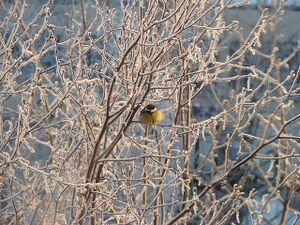قرقف
| Tit | |
|---|---|
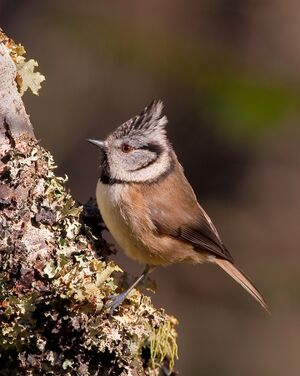
| |
| European crested tit in Scotland | |
| التصنيف العلمي | |
| أصنوفة غير معروفة (أصلحها): | Paridae |
| Genera | |
|
5–10, see text. | |

| |
| Global range (In green) | |
| Synonyms | |
|
See text | |
The tits, chickadees, and titmice constitute the Paridae, a large family of small passerine birds which occur mainly in the Northern Hemisphere and Africa. Most were formerly classified in the genus Parus.
Members of this family are commonly referred to as "tits" throughout much of the English speaking world, but North American species are called either "chickadees" (onomatopoeic, derived from their distinctive "chick-a dee dee dee" alarm call)[1] or "titmice". The name titmouse is recorded from the 14th century, composed of the Old English name for the bird, mase (Proto-Germanic *maison, Dutch mezen, German Meise), and tit, denoting something small. The former spelling, "titmose", was influenced by mouse in the 16th century.[2] Emigrants to New Zealand presumably identified some of the superficially similar birds of the genus Petroica of the family Petroicidae, the Australian robins, as members of the tit family, giving them the title tomtit, although, in fact, they are not related.
These birds are mainly small, stocky, woodland species with short, stout bills. Some have crests. They range in length from 10 to 22 cm (3.9 to 8.7 in). They are adaptable birds, with a mixed diet including seeds and insects.[3] Many species live around human habitation and come readily to bird feeders for nuts or seed, and learn to take other foods.
. . . . . . . . . . . . . . . . . . . . . . . . . . . . . . . . . . . . . . . . . . . . . . . . . . . . . . . . . . . . . . . . . . . . . . . . . . . . . . . . . . . . . . . . . . . . . . . . . . . . . . . . . . . . . . . . . . . . . . . . . . . . . . . . . . . . . . . . . . . . . . . . . . . . . . . . . . . . . . . . . . . . . . . .
الوصف
With the exception of the three monotypic genera Sylviparus, Melanochlora, and Pseudopodoces, the tits are extremely similar in appearance, and have been described as "one of the most conservative avian families in terms of general morphology".[4] The typical body length of adult members of the family is between 10 and 16 cm (3.9 and 6.3 in) in length; when the monotypic genera are added, this range is from 9 to 21 cm (3.5 to 8.3 in). In weight, the family ranges from 5 to 49 g (0.18 to 1.73 oz); this contracts to 7 to 29 g (0.25 to 1.02 oz) when the three atypical genera are removed. The majority of the variation within the family is in plumage, and particularly colour.[5]
The bills of the tits are generally short, varying between stout and fine, depending on diet. The more insectivorous species have finer bills, whereas those that consume more seeds have stouter bills. It is said that tits are evolving longer beaks to reach into bird feeders.[6] The most aberrant bill of the family is possessed by Hume's ground tit of Tibet and the Himalayas, which is long and decurved.[5]
التوزيع والموئل

السلوك
مجتمع الانشطار والاندماج
الأصوات
النظام الغذائي والتغذية
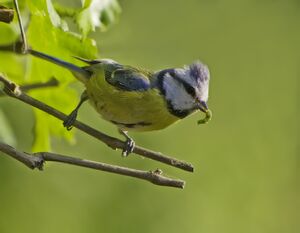
التربية
النظاميات
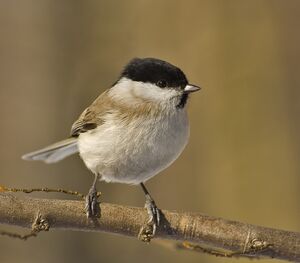
الأنواع في الترتيب التصنيفي
|
| ||||||||||||||||||||||||||||||||||||||||||||||||||||||||||||||||||||||||||||||||||||||||||||||||
| Phylogeny of the Paridae based on Johansson et al. 2013[7] |

Family: PARIDAE[8]
| Image | Genus | Living species |
|---|---|---|
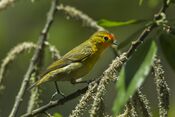 |
Cephalopyrus Bonaparte, 1854 |
|
 |
Sylviparus Burton, 1836 |
|
 |
Melanochlora Lesson, 1839 |
|
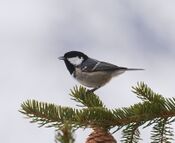 |
Periparus Sélys Longchamps, 1884 |
|
 |
Pardaliparus Sélys Longchamps, 1884 |
|
 |
Lophophanes Kaup, 1829 |
|
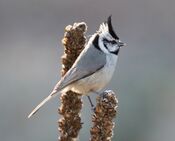 |
Baeolophus Cabanis, 1850 |
|
 |
Sittiparus Selys-Longchamps, 1884 |
|
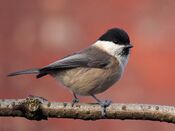 |
Poecile Kaup, 1829 |
|
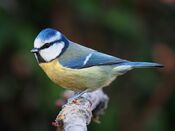 |
Cyanistes Kaup, 1829 |
|
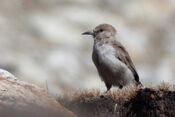 |
Pseudopodoces Zarudny & Loudon, 1902 |
|
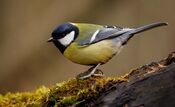 |
Parus Linnaeus, 1758 |
|
 |
Machlolophus Cabanis, 1850 |
|
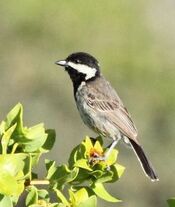 |
Melaniparus Bonaparte, 1850 |
|
. . . . . . . . . . . . . . . . . . . . . . . . . . . . . . . . . . . . . . . . . . . . . . . . . . . . . . . . . . . . . . . . . . . . . . . . . . . . . . . . . . . . . . . . . . . . . . . . . . . . . . . . . . . . . . . . . . . . . . . . . . . . . . . . . . . . . . . . . . . . . . . . . . . . . . . . . . . . . . . . . . . . . . . .
المصادر
- ^ The Merriam-Webster New Book of Word Histories. Springfield, MA, USA: Merriam-Webster. 1991. p. 362. ISBN 0-87779-603-3.
- ^ Douglas Harper (© 2001-2015). "titmouse (n.)". Online Etymology Dictionary. Retrieved 2015-04-28.
{{cite web}}: CS1 maint: numeric names: authors list (link) - ^ Perrins, C. (1991). Forshaw, Joseph (ed.). Encyclopaedia of Animals: Birds. London: Merehurst Press. pp. 202–203. ISBN 1-85391-186-0.
- ^ Gosler & Clement (2007) P.669
- ^ أ ب خطأ استشهاد: وسم
<ref>غير صحيح؛ لا نص تم توفيره للمراجع المسماةHBW - ^ https://news.nationalgeographic.com/2017/10/great-tits-birds-feeders-evolution-beaks/
- ^ Johansson, Ulf S; Ekman, Jan; Bowie, Rauri C.K; Halvarsson, Peter; Ohlson, Jan I; Price, Trevor D; Ericson, Per G.P (2013). "A complete multilocus species phylogeny of the tits and chickadees (Aves: Paridae)". Molecular Phylogenetics and Evolution. 69 (3): 852–860. doi:10.1016/j.ympev.2013.06.019. PMID 23831453.
- ^ Gill, Frank; Donsker, David (eds.). "Waxwings and their allies, tits & penduline tits". World Bird List Version 6.1. International Ornithologists' Union. Retrieved 15 February 2016.
- ^ James, H. F. et al. (2003). Pseudopodoces humilis, a misclassified terrestrial tit (Paridae) of the Tibetan Plateau: evolutionary consequences of shifting adaptive zones. Ibis 145: 185–202.pdf file Archived 2006-09-21 at the Wayback Machine
روابط خارجية
- Titmouse photos & videos on the Internet Bird Collection
خطأ لوا في وحدة:Authority_control على السطر 278: attempt to call field '_showMessage' (a nil value).

